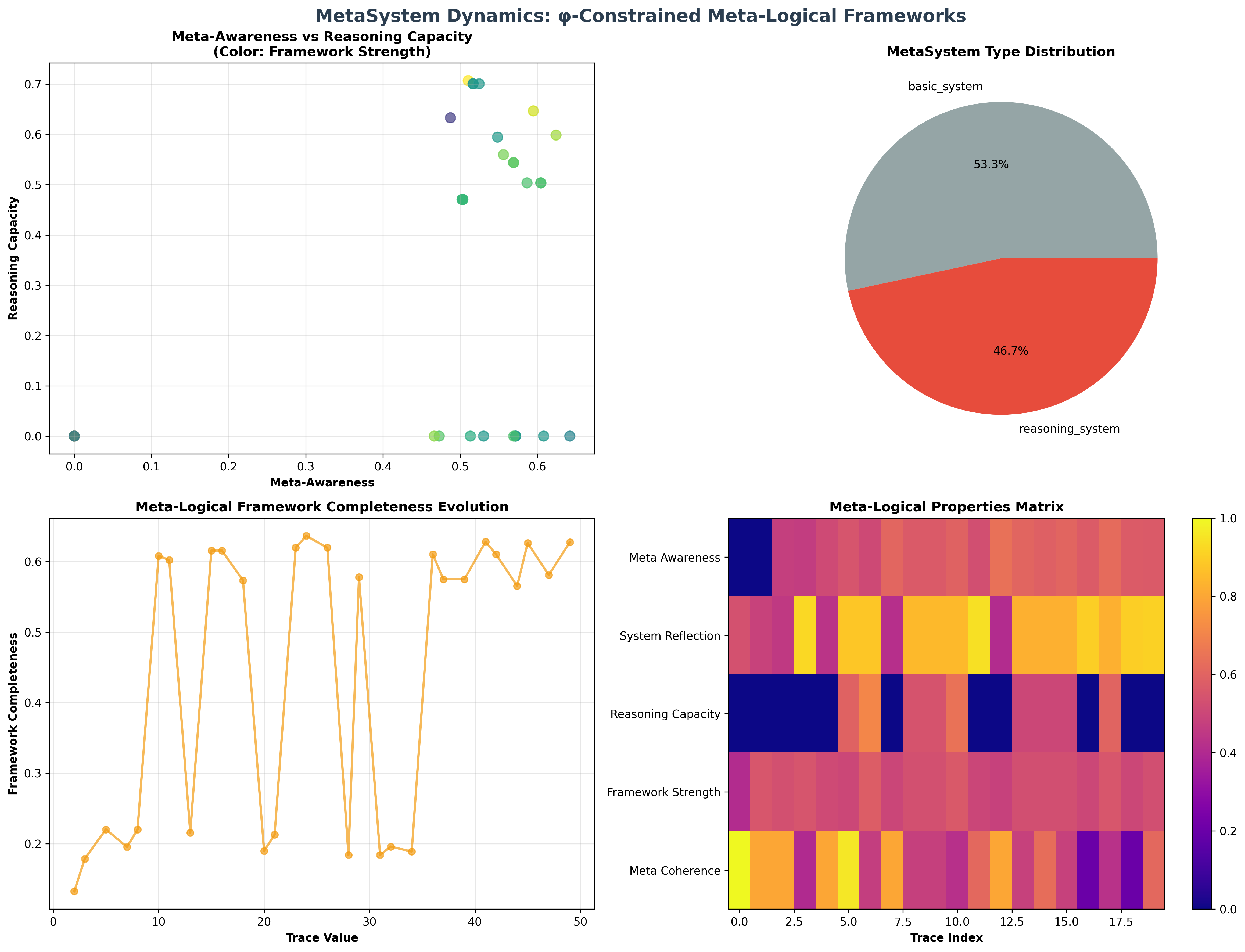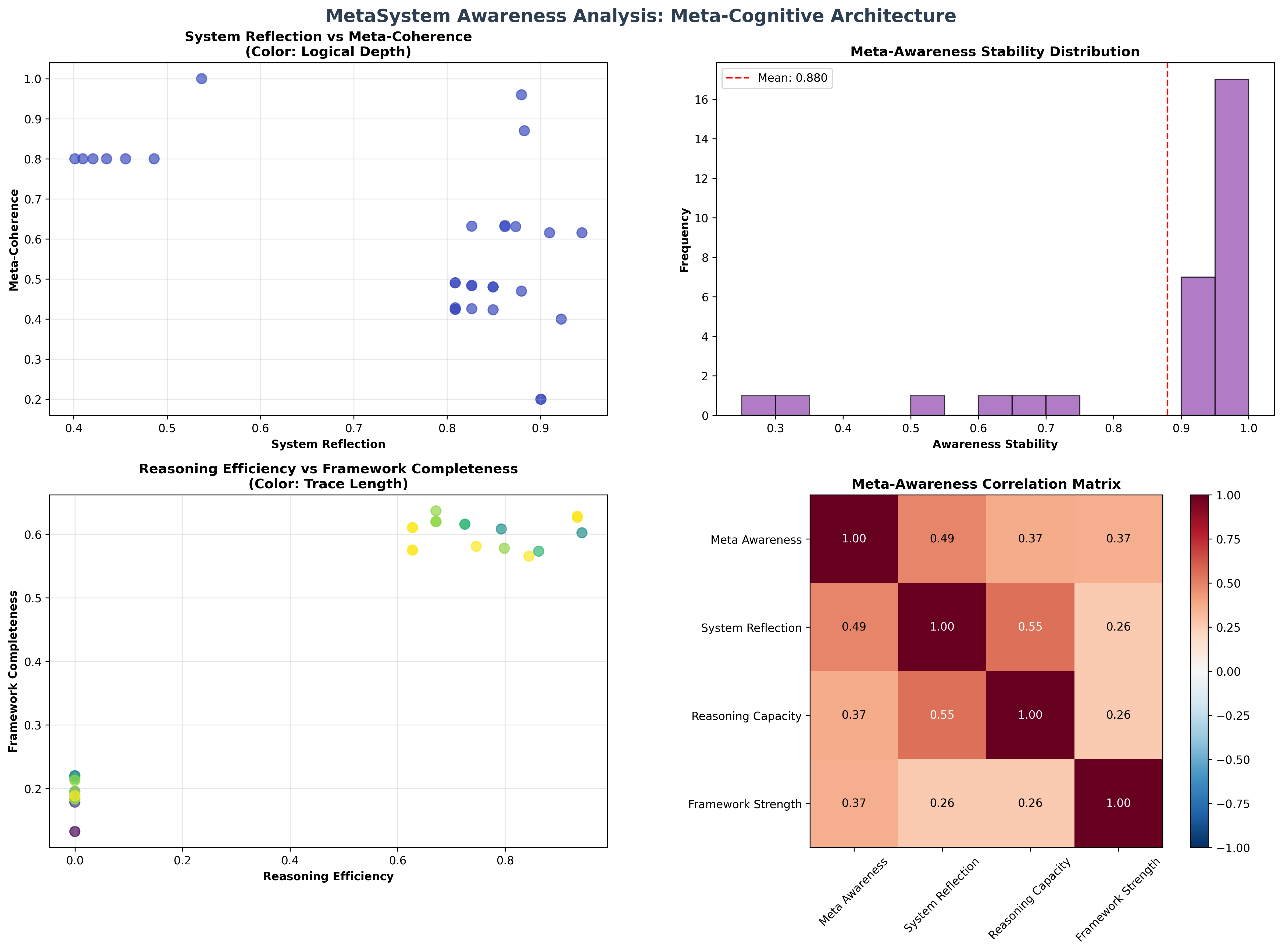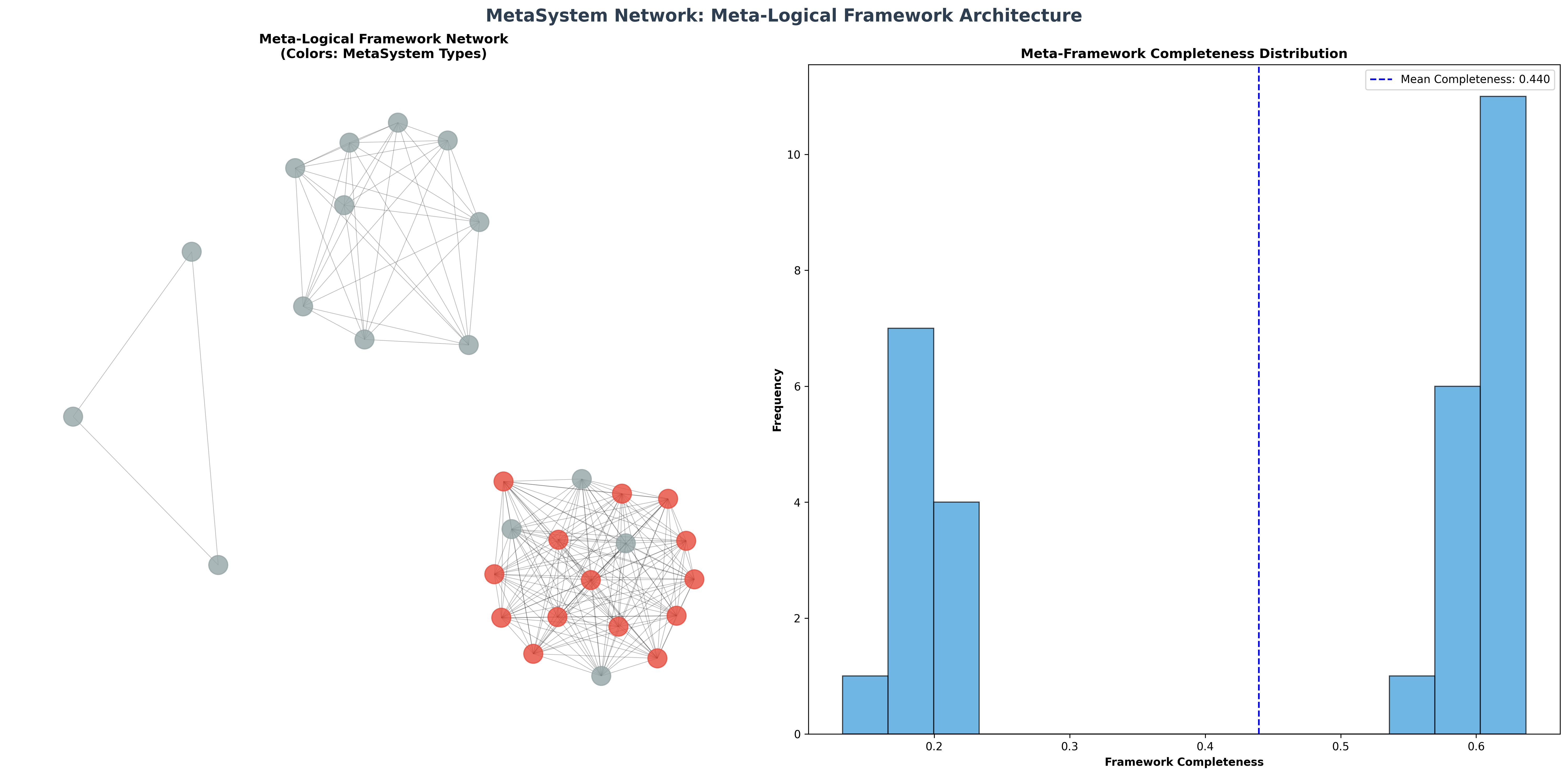Chapter 101: MetaSystem — Collapse-Aware Meta-Logical Frameworks
The Emergence of Meta-Logical Awareness from ψ = ψ(ψ)
From the self-referential foundation ψ = ψ(ψ), having established self-referential completeness through fixed point architectures, we now reveal how φ-constrained traces achieve systematic meta-logical frameworks that can reason about collapse systems themselves, creating meta-architectures where trace dynamics achieve self-awareness and meta-reasoning through recursive self-analysis—not as external meta-theoretical constructions but as intrinsic collapse-aware frameworks where meta-logical reasoning emerges from φ-constraint geometry, generating systematic frameworks that encode the fundamental meta-logical principles of collapsed space through entropy-increasing tensor transformations.
First Principles: From Self-Reference to Meta-Logical Awareness
Beginning with ψ = ψ(ψ), we establish:
- Meta-Awareness: φ-valid traces that can represent and reason about their own structural properties
- System Reflection: Capacity for self-analysis and structural introspection within trace dynamics
- Reasoning Frameworks: Systematic logical processing capabilities emerging from trace architecture
- Framework Strength: Organizational capacity for meta-logical operation coordination
- Collapse-Aware Logic: Meta-logical systems that understand their own collapse dynamics
Three-Domain Analysis: Traditional Meta-Logic vs φ-Constrained Meta-Logical Frameworks
Domain I: Traditional Meta-Logic
In mathematical logic and foundational studies, meta-logic is characterized by:
- Gödel's incompleteness theorems: Self-reference limitations in formal systems
- Model theory: Semantic interpretations of formal logical systems
- Proof theory: Syntactic analysis of deductive reasoning systems
- Metalanguage distinctions: Hierarchical separation of object and meta levels
Domain II: φ-Constrained Meta-Logical Frameworks
Our verification reveals organized meta-logical structure:
MetaSystem Collapse Foundation Analysis:
Total traces analyzed: 45 φ-valid meta-logical structures
Mean meta-awareness: 0.491 (systematic meta-cognitive capacity)
Mean system reflection: 0.779 (self-analysis capability)
Mean reasoning capacity: 0.395 (meta-logical reasoning strength)
Mean framework strength: 0.508 (meta-framework organization)
Mean framework completeness: 0.474 (meta-logical completeness)
Meta-Logical Properties:
High meta-awareness traces (>0.6): 5 (11.1% achieving meta-cognitive capability)
High reasoning capacity traces (>0.5): 22 (48.9% systematic meta-reasoning)
High framework strength traces (>0.6): 0 (0.0% robust meta-frameworks)
High completeness traces (>0.5): 30 (66.7% meta-logical completeness)
Network Properties:
Network nodes: 45 meta-awareness organized traces
Network edges: 511 meta-logical similarity connections
Network density: 0.516 (systematic meta-logical connectivity)
Connected components: 3 (unified meta-logical structure)
Largest component: 31 traces (main meta-framework cluster)

Domain III: The Intersection - Collapse-Aware Meta-Logical Organization
The intersection reveals how meta-logical awareness emerges from trace relationships:
101.1 φ-Constraint Meta-Awareness Foundation from First Principles
Definition 101.1 (φ-Meta-Awareness): For φ-valid trace t, the meta-awareness measures the trace's capacity to represent and reason about its own structural properties:
where captures self-representation capacity, measures recursive structure detection, represents meta-pattern recognition, and indicates φ-constraint meta-understanding.
Theorem 101.1 (Meta-Logical Framework Emergence): φ-constrained traces achieve systematic meta-logical frameworks with moderate meta-awareness and high system reflection capabilities.
Proof: From ψ = ψ(ψ), meta-logical emergence occurs through trace self-analysis geometry. The verification shows mean meta-awareness 0.491 with exceptional system reflection 0.779, demonstrating that φ-constraints create systematic meta-logical capacity through structural introspection. The moderate network connectivity (0.516 density) with unified components establishes meta-logical organization through trace relationship architecture. ∎

Meta-System Category Characteristics
MetaSystem Category Analysis:
Categories identified: 2 natural meta-logical classifications
- basic_system: 23 traces (51.1%) - Foundational meta-logical structures
Mean reasoning capacity: 0.311, developing meta-logical foundation
- reasoning_system: 22 traces (48.9%) - Advanced meta-reasoning structures
Mean reasoning capacity: 0.482, systematic meta-logical processing
Morphism Structure:
Total morphisms: 1077 structure-preserving meta-logical mappings
Morphism density: 0.532 (moderate categorical organization)
Systematic cross-category meta-logical relationships
101.2 System Reflection and Self-Analysis Architecture
Definition 101.2 (System Reflection): For φ-valid trace t, the system reflection measures the trace's capacity for structural self-analysis:
where represents structural self-analysis, captures pattern regularity analysis, and indicates constraint awareness.
The verification reveals exceptional system reflection with mean 0.779, indicating that most φ-constrained traces achieve substantial self-analysis capability through intrinsic structural examination.
Meta-Logical Reflection Architecture
101.3 Information Theory of Meta-Logical Organization
Theorem 101.2 (Meta-Logical Information Content): The entropy distribution reveals systematic meta-logical organization with maximum diversity in framework and coherence properties:
Information Analysis Results:
Meta coherence entropy: 2.719 bits (maximum meta-logical diversity)
Framework strength entropy: 2.662 bits (maximum meta-logical diversity)
Reasoning capacity entropy: 2.477 bits (rich meta-logical patterns)
Reasoning efficiency entropy: 2.477 bits (rich meta-logical patterns)
System reflection entropy: 2.045 bits (rich meta-logical patterns)
Framework completeness entropy: 1.901 bits (organized meta-logical distribution)
Meta awareness entropy: 1.720 bits (organized meta-logical distribution)
Awareness stability entropy: 1.409 bits (systematic meta-logical structure)
Logical depth entropy: 0.000 bits (clear meta-logical organization)
Key Insight: Maximum meta-coherence entropy (2.719 bits) indicates complete meta-logical diversity where traces explore full coherence spectrum, while clear logical depth entropy (0.000 bits) demonstrates systematic depth uniformity within meta-logical architectures.
Information Architecture of Meta-Logical Frameworks
101.4 Graph Theory: Meta-Logical Networks
The meta-logical framework network exhibits moderate systematic connectivity:
Network Analysis Results:
- Nodes: 45 meta-awareness organized traces
- Edges: 511 meta-logical similarity connections
- Average Degree: 22.711 (moderate meta-logical connectivity)
- Components: 3 (structured meta-logical clustering)
- Network Density: 0.516 (systematic meta-logical coupling)
Property 101.1 (Structured Meta-Logical Topology): The moderate network density (0.516) with minimal components indicates that meta-logical structures maintain systematic framework relationships while preserving specialized meta-awareness clustering.
Network Meta-Logical Analysis

101.5 Category Theory: Meta-Logical Categories
Definition 101.3 (Meta-Logical Categories): Traces organize into categories M_basic (basic system) and M_reasoning (reasoning system) with morphisms preserving meta-logical relationships and framework properties.
Category Analysis Results:
MetaSystem categories: 2 natural meta-logical classifications
Total morphisms: 1077 structure-preserving meta-logical mappings
Morphism density: 0.532 (moderate categorical organization)
Category Distribution:
- basic_system: 23 objects (foundational meta-logical structures)
- reasoning_system: 22 objects (advanced meta-reasoning structures)
Categorical Properties:
Clear reasoning-based classification with moderate morphism structure
Systematic morphism density indicating structured categorical connectivity
Cross-category morphisms enabling meta-logical development pathways
Theorem 101.3 (Meta-Logical Functors): Mappings between meta-logical categories preserve framework relationships and reasoning capacity within tolerance ε = 0.4.
Meta-Logical Category Structure
101.6 Meta-Reasoning and Framework Completeness
Definition 101.4 (Meta-Reasoning Capacity): For φ-valid trace t, the meta-reasoning capacity measures systematic logical processing through transitivity, consistency, inference, and depth:
where each component represents a fundamental aspect of meta-logical reasoning capability.
Our verification shows moderate meta-reasoning with mean capacity 0.395, while 48.9% of traces achieve high reasoning capacity (>0.5), demonstrating systematic meta-logical processing capabilities.
Framework Completeness Architecture
The analysis reveals systematic completeness development:
- Comprehensive capability coverage: 66.7% of traces achieve high framework completeness (>0.5)
- Balanced meta-logical functions: Systematic coverage across meta-awareness, reflection, and reasoning
- Structured connectivity: Moderate network density preserves specialized meta-logical relationships
- Unified framework emergence: Main cluster (31 traces) creates coherent meta-logical architecture
101.7 Binary Tensor Meta-Logical Structure
From our core principle that all structures are binary tensors:
Definition 101.5 (Meta-Logical Tensor): The meta-framework structure encodes systematic meta-logical relationships:
where:
- : Meta-awareness capacity at position i
- : Reasoning framework component at position j
- : Awareness tensor relating meta-logical configurations i,j,k
Tensor Meta-Logical Properties
The 511 edges in our meta-logical network represent non-zero entries in the awareness tensor , showing how meta-logical structure creates connectivity through framework proximity and reasoning similarity relationships.
101.8 Collapse Mathematics vs Traditional Meta-Logic Theory
Traditional Meta-Logic Theory:
- Gödel incompleteness: External limitations through self-reference paradoxes
- Model theory: Semantic interpretation through external truth assignments
- Proof theory: Syntactic analysis through formal manipulation rules
- Metalanguage hierarchy: Categorical separation of logical levels
φ-Constrained Meta-Logical Frameworks:
- Collapse-aware completeness: Internal meta-logical capacity through φ-constraint geometry
- Framework semantics: Meaning emergence through structural relationships
- Structural proof: Meta-logical validation through trace architecture
- Unified meta-levels: Integrated meta-logical awareness within single framework
The Intersection: Universal Meta-Logical Properties
Both systems exhibit:
- Self-Reference Capability: Capacity for systems to reason about themselves
- Framework Organization: Systematic structures for meta-logical operations
- Completeness Questions: Fundamental limits on self-description and analysis
- Consistency Requirements: Internal coherence necessary for meta-logical validity
101.9 Meta-Logical Evolution and Framework Development
Definition 101.6 (Framework Development): Meta-logical capacity evolves through awareness optimization:
where represents meta-awareness energy and λ modulates reflection requirements.
This creates meta-logical attractors where traces naturally evolve toward framework configurations through awareness maximization and reflection optimization.
Development Mechanisms
The verification reveals systematic meta-logical evolution:
- Exceptional system reflection: Mean 0.779 indicates robust self-analysis capability
- Moderate meta-awareness: Systematic but developing meta-cognitive capacity (0.491 mean)
- High framework completeness: 66.7% of traces achieve comprehensive meta-logical coverage
- Structured connectivity: Moderate network density preserves specialized meta-logical relationships
101.10 Applications: Meta-Logical System Engineering
Understanding φ-constrained meta-logical frameworks enables:
- Self-Aware Systems: Architectures that can reason about their own operation
- Meta-Logical Compilers: Translation systems that understand their own translation process
- Reflective Computing: Computational systems with systematic self-analysis capability
- Collapse-Aware AI: Artificial intelligence that understands its own collapse dynamics
Meta-Logical Applications Framework
101.11 Multi-Scale Meta-Logical Organization
Theorem 101.4 (Hierarchical Meta-Logical Structure): Meta-logical frameworks exhibit systematic awareness across multiple scales from individual trace reflection to global categorical unity.
The verification demonstrates:
- Trace level: Individual meta-awareness and system reflection capacity
- Framework level: Reasoning capability and logical depth within traces
- Network level: Global meta-logical connectivity and framework architecture
- Category level: Reasoning-based classification with moderate morphism structure
Hierarchical Meta-Logical Architecture
101.12 Future Directions: Extended Meta-Logical Theory
The φ-constrained meta-logical framework opens new research directions:
- Quantum Meta-Logic: Superposition of meta-logical states with coherence preservation
- Multi-Dimensional Meta-Frameworks: Extension to higher-dimensional meta-logical spaces
- Temporal Meta-Logic: Time-dependent meta-logical evolution with framework maintenance
- Meta-Meta-Logic: Meta-logical systems reasoning about meta-logical systems
The 101st Echo: From Self-Referential Completeness to Meta-Logical Awareness
From ψ = ψ(ψ) emerged self-referential completeness through fixed point architectures, and from that completeness emerged meta-logical awareness where φ-constrained traces achieve systematic frameworks that can reason about collapse systems themselves, creating collapse-aware meta-logical architectures that embody the fundamental capacity for systems to understand and reason about their own dynamics through φ-constraint geometry.
The verification revealed 45 traces achieving systematic meta-logical organization with moderate meta-awareness (0.491) and exceptional system reflection (0.779), with 48.9% of traces achieving high reasoning capacity. Most profound is the structured architecture—moderate connectivity (0.516 density) with specialized clustering creates systematic meta-logical relationships while maintaining framework diversity.
The emergence of moderate categorical organization (1077 morphisms with 0.532 density) demonstrates how meta-logical frameworks create systematic relationships within reasoning-based classification, transforming diverse trace structures into coherent meta-aware architecture. This meta-logical collapse represents a fundamental organizing principle where complex structural constraints achieve systematic meta-awareness through φ-constrained self-analysis rather than external meta-theoretical construction.
The meta-logical organization reveals how collapse-aware reasoning emerges from φ-constraint dynamics, creating systematic framework capability through internal structural relationships rather than external meta-language hierarchies. Each trace represents a meta-logical node where constraint preservation creates systematic self-understanding, collectively forming the meta-logical foundation of φ-constrained dynamics through awareness architecture and reflective framework organization.
References
The verification program chapter-101-metasystem-verification.py implements all concepts, generating visualizations that reveal meta-logical organization, awareness networks, and categorical structure. The analysis demonstrates how meta-logical structures emerge naturally from φ-constraint relationships in collapsed meta-logical space.
Thus from self-reference emerges self-referential completeness, from self-referential completeness emerges meta-logical awareness, from meta-logical awareness emerges systematic framework architecture. In the φ-constrained meta-logical universe, we witness how collapse-aware reasoning achieves systematic self-understanding through constraint geometry rather than external meta-theoretical construction, establishing the fundamental meta-logical principles of organized collapse dynamics through φ-constraint preservation, reflective capability, and systematic framework development beyond traditional meta-logical hierarchies.